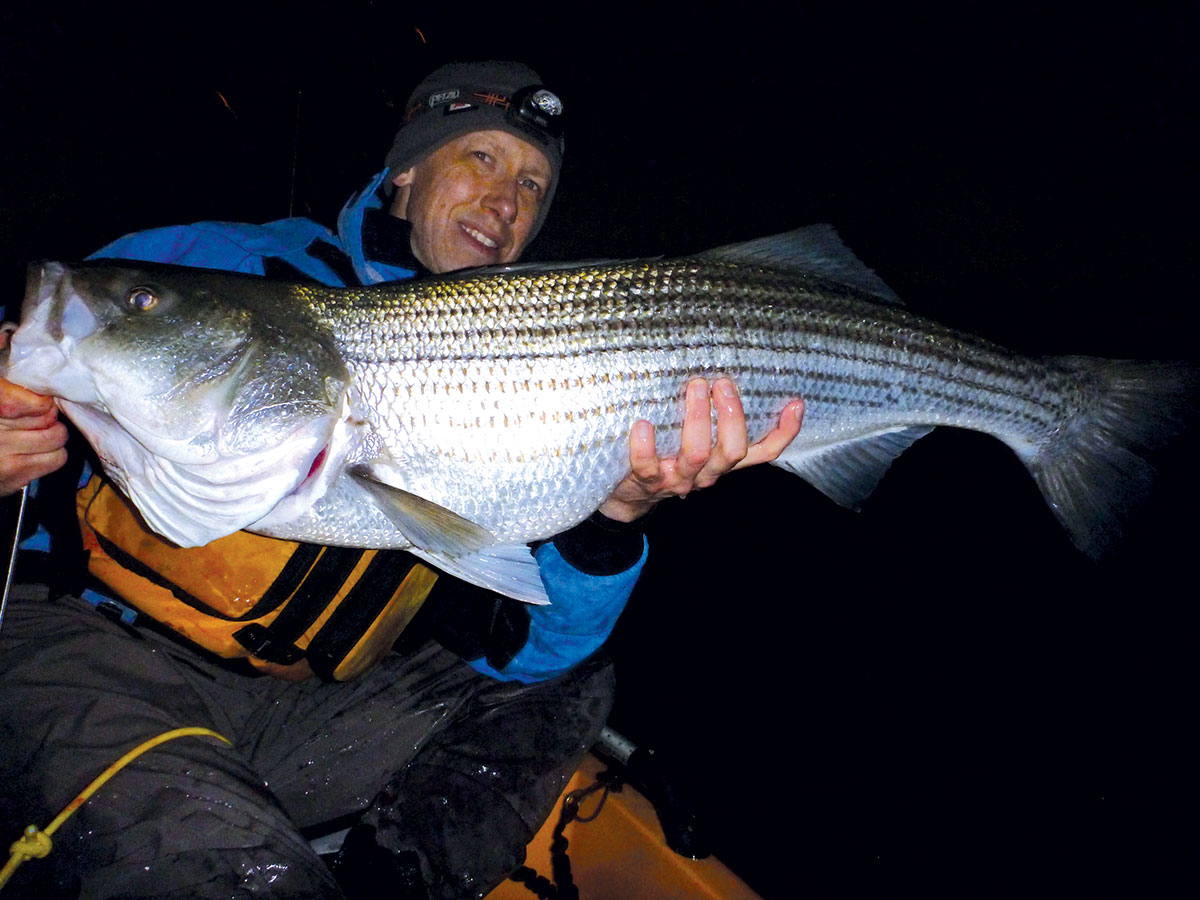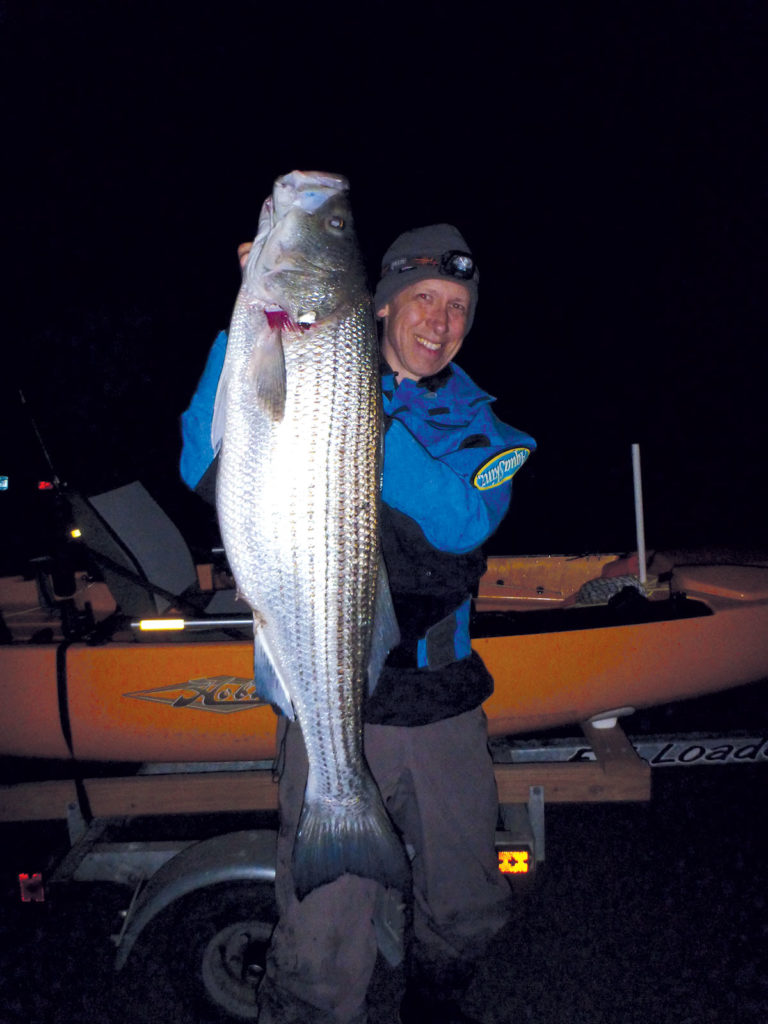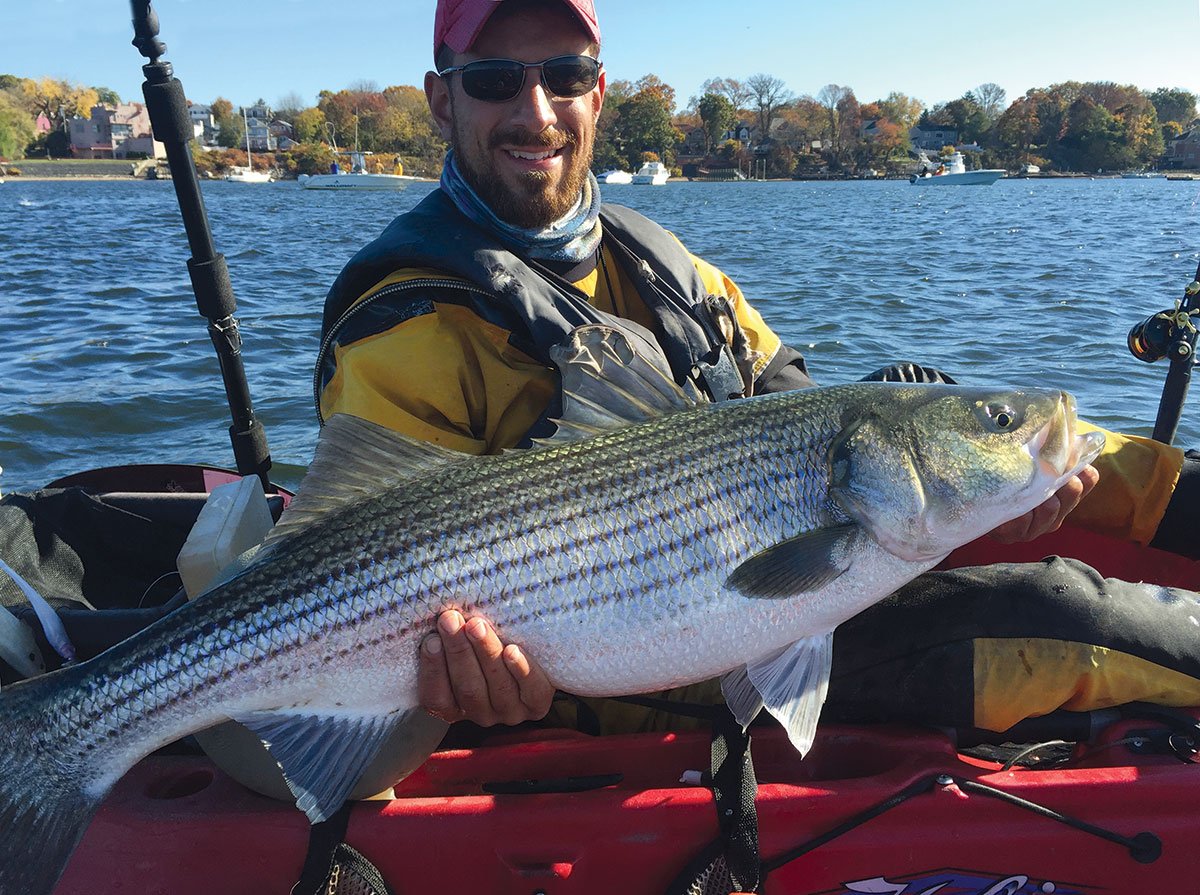
One click, that’s all I heard. I was sitting in my ‘yak anchored not 200 feet from the beach, deep inside a harbor on the North Shore of Long Island. The night was so still the only sounds I could hear were a few splashes of distant bunker, and a lone owl occasionally calling on the shore. Then, came that single click. I carefully picked up the rod from its holder and engaged the reel, but felt no resistance; the line was slack. I began to retrieve, but still, there was nothing. Had my line been severed by a bluefish or barnacle-encrusted boulder? Finally, as the line came taught, the water immediately to my right exploded, and I was drenched with a shower of spray. The bass had picked up my bait and sidled right up next to me to gulp it down! I immediately backed off on the drag just as the fish made its first searing run. Several minutes later, I had the beautiful 42-inch fish back at my side, to be unhooked and sent on its way after posing for a few pics.
It’s nights like the one I’ve just recounted that lure me out into the night in my kayak to soak fresh bunker chunks every May and June. Most kayak anglers prefer to troll a tube-and-worm or plugs for bass. For much of the season I do this as well. While these methods are highly effective and account for numbers of fish, big ones are often hard to come by. Chunking at night is a simple and relatively foolproof way to cull out some of the largest bass in an area.
Each spring, striped bass that have finished spawning in the Hudson make their way down the river and gradually filter eastward through Long Island Sound and up into New England, while those that have spawned in the Chesapeake work their way north into Delaware and Raritan bays before turning east along Long Island’s South Shore. During the months of May and June, rising water temps and abundant bait in the form of bunker draw these hungry post-spawn fish deep into the many harbors and bays that indent the Striper Coast. This situation provides an excellent opportunity for the kayak angler to connect with some hefty fish without having to paddle for miles or brave extreme conditions. Most of the bass you’re likely to encounter during this event run roughly 15 to 30 pounds, with much larger fish always a possibility.
Striped bass, like all predators, try to conserve energy whenever possible, and will take advantage of any opportunity to secure a meal without having to chase it down. An ideal feeding scenario for a large bass is to find a site where bluefish have recently massacred a school of bunker. Bluefish attack bunker tail-first, leaving the heads to sink to the bottom. Bass, which always swallow their prey head-first, often take advantage of this windfall, cleaning up after the blues by filling up on their leftovers. Shallow water chunking is an effective strategy because it simulates such a situation.
Admittedly, kayaks are not ideal craft for chunking. The advantage here is that you will be able to target quality fish in relatively tranquil, shallow waters where they would be easily spooked by a larger craft. Your equipment is minimal, and you can fish with little or no weight. There is the added plus of feeling a much more personal connection with your surroundings, as well as with your quarry. Yes, chunking requires some sitting around waiting for a pickup, but what may seem boring on a powerboat becomes meditative while floating in your ‘yak at water level on a calm night. Here, I explain how I’ve adapted this popular, time-tested technique to the limitations of a tiny boat.
Bait Prep
Fishing chunks from a kayak is a simple operation, but unless you enjoy cutting up bloody fish in your lap, I advise you prep your bait in advance. I take the freshest bunker I can get, preferably caught that same day, and from each one cut off the head as well as the first chunk, which contains the guts. These baits go into a gallon zip-lock bag and then into a small cooler with ice. The remainder of the bunker bodies are processed through a meat grinder and go into a separate zip-lock bag, and then into the cooler with the chunks and heads.
This ensures everything stays tidy out on the water. If you don’t have a meat grinder it’s no matter. You can do just fine chopping up the bunker tails into small pieces with a knife. Before I got my grinder I sometimes put the cut up bits in a bucket and mash them for a few minutes with a scrap piece of 2×4. Processing the chum is an optional step, but it can make a difference in your success rate. While all this may sound like a chore, the total prep time for me is usually about a half-hour including cleanup, and of course, once on the water you have nothing left to do but relax and fish.

Gearing Up
There is no specific rod and reel combination that I consider essential for chunking from a kayak; this is not a finesse technique. You neither have to cast far, nor have to feel for a subtle bite. As long as your rod is substantial enough to handle the fish, and your reel has a clicker setting, you’ll be okay. There are two outfits that I regularly employ. The first is a 7-foot St. Croix Tidewater series inshore baitcaster. It’s a med-heavy action rod rated for 10- to 20-pound line matched with a Shimano Calcutta 400b reel. The other is a 7-foot med-heavy action spinning rod, also rated for 10- to 20-popund line, paired with a 4000 series Shimano Baitrunner reel.
Monofilament line is preferable to braid for this fishing method. For some reason, when braided line rests on the bottom it seems to come to life and find its way into all kinds of tangled trouble. Every reel I own is spooled with braid, but instead of having separate reels filled with mono, I simply add a 25-foot topshot of 25-pound Trilene Big Game, attached to the braid with either an Alberto or a Uni-to-Uni knot. This is enough to ensure that only the mono rests on the bottom, and practically eliminates the risk of tangles. The terminal tackle is simple. I use an 8/0 Gamakatsu octopus circle hook snelled to a 4-foot leader of 50-pound monofilament, and attached to the main line by a barrel swivel. Circle hooks are musts to avoid gut-hooking fish – I can’t stress this point strongly enough. To finish off the rig, I attach a 1/2-ounce crimp-on sinker to the leader, near the swivel. This helps to keep the bait from rolling around on the bottom and getting fouled, as well as allowing me to keep the line slightly taught so that the clicker sounds even if a bass just bumps the bait with its nose.
Locate Structure
One can set up almost anywhere along the coast where bunker and big stripers meet and conditions are suitable for kayaking. This technique shines in the shallows of the many bays and harbors that abound from Delaware Bay to Cape Cod, including those that dot both shorelines of Long Island Sound. There are some features you can look for to increase your chances when fishing these areas. As bass often move in and out of harbors and bays with the tide, it’s a good idea to set up near some kind of shoreline structure that they have to navigate around, such as a point, bar, or jetty. If there are boulders present in the area you fish, this is a good place to start since bass like to forage amongst them. Studying a chart is also helpful to reveal underwater structures, which may act to divert and thereby concentrate the fish. Don’t be afraid to set up a stone’s throw from shore. Bars, which occur at the mouths of many bays and harbors, are definitely hotspots for bass, but these areas are best fished around the last hour before and after slack water to avoid the stronger currents usually present in these areas. Hard running currents require heavier weights to stay on the bottom.

Try to avoid well known fishing areas that attract powerboats or crowds of surfcasters. One of the great advantages of kayak fishing is stealth so why compromise it? This is also where you’ll likely find other fishermen, either on shore or in powerboats, which is something the wise kayak angler avoids. Tidal stage is often a very important factor for back-bay chunking. Unfortunately, the ideal tidal stage varies from location to location. Make sure to keep a log of your trips to help you identify the magic hour. Once you’re dialed into the fish in a particular spot, the time of their future appearance can often be predicted. My final tip for location is to stay at least 200 feet from any mooring buoys or navigational aids. Many harbors and some bays are crowded with these hazards. If you are fighting a running fish and your line comes in contact with one of their anchor chains, it’s game over.
I usually drop anchor in 8 to 15 feet of water. If your ‘yak is rigged with an anchor trolley, run the anchor line out the stern so that you and your baits face down-current. Put a portion of your chum in a small bucket, mix in some water, and either pour or ladle it over the side. If space is limited you can also deploy your chum in a mesh bag hung over the side. To rig your baits, hook your heads once through the shoulder, and the chunks through the thick dorsal side, making sure there are no scales stuck on the point of your hook. You don’t have to lob the baits out far, 20 to 25 feet is plenty enough. I often start by fishing one rod with a bunker head, and another with a chunk, as some nights the fish have a preference for one over the other. I set up the baits at roughly 10 o’clock and 2 o’clock in relation to my bow. After I get my first fish, I start fishing with only one rod, to avoid the chaos of a double-hookup. Change the baits and re-deploy chum every 15 to 20 minutes, putting the used chunks in your extra zip-lock bag. If the bite is hot and you run out of bait, those recycled chunks work just fine. Also, make sure your rods are leashed before setting them in their holders. If you get a runoff and the reel accidentally slips into gear you could end up having an expensive trip.
When you get a pickup, you’ll most likely hear a few short bursts of the clicker as the fish grabs the bait and works on gulping it down. Wait until the fish begins to move off steadily with the bait; that’s the time to engage the reel. Remember to not try and set the hook. Let the line tighten up on its own as the fish runs; this helps to properly position the circle hook in the corner of the mouth. If you are getting a lot of jerky, short runoffs, and are not hooking up, you may think you’re doing something wrong, but the cause is most likely small fish that are having trouble swallowing the bait. Just be patient and wait for the big one to come along. When you get your first fish, don’t waste too much time taking pics and texting your buddies before setting out another bait. Often, the fish move through all at once in a short period of time and then be gone for the rest of the night.

Play It Safe
Finally, a few parting words about safety. I consider night to be the safest time to fish from a kayak, as there are fewer powerboats out on the water than there are during the day. However, kayaking is still a potentially dangerous sport. Fish with a buddy, if possible, or at least inform someone where you intend to fish, and for how long. A flotation vest is a must, and should be worn, not stowed, at all times. Until about the first week of June, water temperatures are still too cold to risk immersion without protective clothing. A semi-dry outfit composed of waterproof stocking foot pants and neoprene diving booties, plus a semi-dry top, which is water resistant up to the collar, will keep you protected for long enough to re-board your yak should you end up in the water. Having a quality headlamp makes everything about your trip easier and safer as well.
Chunking bass from a kayak in the shallows provides a unique opportunity to tangle with a trophy striper in relatively calm, protected waters. For me, there are few greater thrills in fishing than sitting in quiet contemplation while bobbing in my little boat at night, then having the silence shattered by a screaming runoff. This season why not pick up a dozen fresh ones and give it a try? Once you hear that clicker sing, I’m sure you’ll agree that it’s a moment well worth waiting for.





